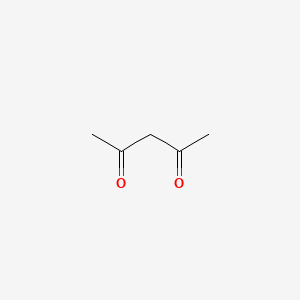| MeSH term | MeSH ID | Detail |
|---|---|---|
| Adenocarcinoma | D000230 | 166 associated lipids |
| Body Weight | D001835 | 333 associated lipids |
| Dermatitis, Contact | D003877 | 59 associated lipids |
| Eczema | D004485 | 4 associated lipids |
| Edema | D004487 | 152 associated lipids |
| Fetal Resorption | D005327 | 15 associated lipids |
| Glioma | D005910 | 112 associated lipids |
| Nervous System Diseases | D009422 | 37 associated lipids |
| Purpura, Thrombocytopenic | D011696 | 2 associated lipids |
| Seizures | D012640 | 87 associated lipids |
2,4-pentanedione
2,4-pentanedione is a lipid of Fatty Acyls (FA) class. The related lipids are Butyrates.
Cross Reference
Introduction
To understand associated biological information of 2,4-pentanedione, we collected biological information of abnormalities, associated pathways, cellular/molecular locations, biological functions, related genes/proteins, lipids and common seen animal/experimental models with organized paragraphs from literatures.
What diseases are associated with 2,4-pentanedione?
There are no associated biomedical information in the current reference collection.
Possible diseases from mapped MeSH terms on references
We collected disease MeSH terms mapped to the references associated with 2,4-pentanedione
PubChem Associated disorders and diseases
What pathways are associated with 2,4-pentanedione
There are no associated biomedical information in the current reference collection.
PubChem Biomolecular Interactions and Pathways
Link to PubChem Biomolecular Interactions and PathwaysWhat cellular locations are associated with 2,4-pentanedione?
There are no associated biomedical information in the current reference collection.
What functions are associated with 2,4-pentanedione?
There are no associated biomedical information in the current reference collection.
What lipids are associated with 2,4-pentanedione?
Related references are published most in these journals:
| Lipid concept | Cross reference | Weighted score | Related literatures |
|---|
What genes are associated with 2,4-pentanedione?
There are no associated biomedical information in the current reference collection.
What common seen animal models are associated with 2,4-pentanedione?
There are no associated biomedical information in the current reference collection.
NCBI Entrez Crosslinks
All references with 2,4-pentanedione
Download all related citations| Authors | Title | Published | Journal | PubMed Link |
|---|---|---|---|---|
| Cacic M et al. | Synthesis and antimicrobial activity of some derivatives of (7-hydroxy-2-oxo-2H-chromen-4-yl)-acetic acid hydrazide. | 2006 | Molecules | pmid:17962784 |
| Wang CY et al. | Inhibition by diacylmethane derivatives of mutagenicity in Salmonella typhimurium and tRNA-binding of chemical carcinogens. | 1991 | Mutat. Res. | pmid:1900573 |
| Mazumder V et al. | A facile synthesis of MPd (M = Co, Cu) nanoparticles and their catalysis for formic acid oxidation. | 2012 | Nano Lett. | pmid:22276672 |
| Luo M et al. | Enhanced Luminescence of Eu-Doped TiO2Nanodots. | 2009 | Nanoscale Res Lett | pmid:20596343 |
| Wang J et al. | Increases in solar conversion efficiencies of the ZrO2 nanofiber-doped TiO2 photoelectrode for dye-sensitized solar cells. | 2012 | Nanoscale Res Lett | pmid:22297154 |
| Jin EM et al. | Enhancement of the photoelectric performance of dye-sensitized solar cells using Ag-doped TiO2 nanofibers in a TiO2 film as electrode. | 2012 | Nanoscale Res Lett | pmid:22297128 |
| Trusova EA et al. | Wet-chemistry processing of powdery raw material for high-tech ceramics. | 2012 | Nanoscale Res Lett | pmid:22221657 |
| Premkumar T et al. | Shape-tailoring and catalytic function of anisotropic gold nanostructures. | 2011 | Nanoscale Res Lett | pmid:21974964 |
| She H et al. | A nonaqueous approach to the preparation of iron phosphide nanowires. | 2010 | Nanoscale Res Lett | pmid:20672078 |
| Wu W et al. | Magnetic iron oxide nanoparticles: synthesis and surface functionalization strategies. | 2008 | Nanoscale Res Lett | pmid:21749733 |
